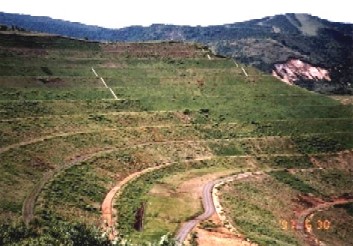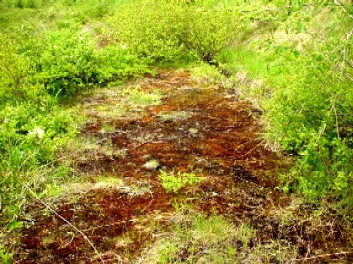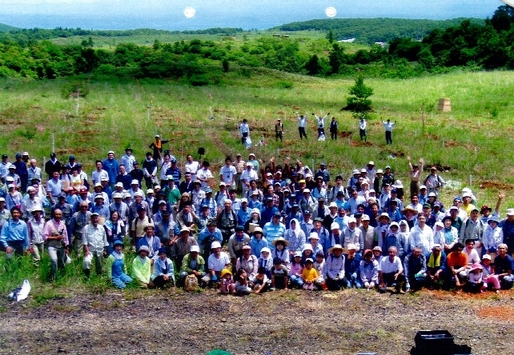Tree planting on the former Matsuo Mine site
This year tree-planting work was once again organized by the Environmental Conservation Section
This year’s tree-planting event from the Environmental Preservation Division was held on September 3rd, 2016.
Why do we plant trees?

The forest on the site of the former Matsuo Mine was devastated by the open-cast mines and slag heap deposits. With the prefecture’s work at the source of the pollution, the area has recovered to become grasslands, but the poor quality of the soil means that fertilizer must be applied every few years or else the grass will die off. Trees and shrubs in the surrounding areas are too far away to spread into this site, and seeds planted in the soil do not spread their roots in the underdeveloped humus layer. A mat of lichen now flourishes on what was once barren soil, but that makes it even harder for seeds to take root.

The Tohoku Area Environmental Planning and Research Group, a group of people with academic standing and experience in this field, were consulted about the situation. Based on their investigation and research, it was deemed necessary to purposely plant trees ourselves in order to encourage vegetation to naturally spread to the site. Leaving the site alone would only result in the return of a barren wasteland.
Tree-planting Activities
An Iwate company made a proposal to the prefectural government and began trial planting on the site of the open-cast mines in 1986. Following that, a few other groups, including the Tohoku Area Environmental Planning and Research Group, carried out trial planting on small plots of land as well.
Between 2002 and 2004, the Tohoku Area Environmental Planning and Research Group carried out trial planting on a larger scale. Beginning in 2005, they called on residents in the prefecture to participate as well, and numbers grew each year, with 200 people taking part in 2007.
The trees planted were species found growing in the areas around the mine including Erman’s birch, Japanese silverberry, a species of Japanese alder, and Japanese rowan.
In other developments, the Moribito Project Committee opened their Michinoku Office in April 2008, and their work includes making seed pots. Since 2009, they have made about 32,000 seed pots and they began planting those trees in 2010.
As these projects developed, an association was needed to oversee forest cultivation and environmental studies, as well as to give guidance and advice to other groups concerning the regeneration of the Matsuo Mine site. In 2010, the Matsuo Mine Forest Regeneration Association was formed. (Members as of April 2015: Tohoku Area Environmental Planning and Research Group; Moribito Forest Project; Environmental, Ecological and Engineering Research Center; Matsuo Forest Regeneration Research Group; Environmental Preservation Division of Iwate Prefectural Government)
The owners of the land, the Morioka Forest Management Office (currently under the jurisdiction of the Northern Iwate Forest Management Office), entered into an agreement with the Association and Iwate Prefectural Government that use the land for forest cultivation at the former Matsuo Mine or for running events there. The agreement was signed on May 20th, 2010.

関連情報
このページに関するお問い合わせ
Mining and Water Resources Section (Mining), Environmental Preservation Division,
Department of Environment and Residential Life
(020-8570) 10-1 Uchimaru, Morioka, Iwate, JAPAN
TEL:019-629-5358 FAX:019-629-5364

